Abstract
Kinetic studies of the glucose-dependent monomer-dimer reaction of yeast hexokinase PI at pH 8.0 in the presence of 0.1 M-KCl have been carried out using the fluorescence temperature-jump technique. A slow-relaxation effect was observed which was attributed from its dependence on enzyme concentration to the monomer-dimer reaction; the reciprocal relaxation times tau-1 varied from 3 s-1 at low concentrations of glucose to 42 s-1 at saturating concentrations. Rate constants for association (kass.) and dissociation (kdiss.) were determined as a function of glucose concentration using values of the equilibrium association constant of the monomer-dimer reaction derived from sedimentation ultracentrifugation studies under similar conditions, and also from the dependence of tau-2 on enzyme concentration. kass. was almost independent of glucose concentration and its value (2 x 10(5) M-1.s-1) was close to that expected for a diffusion-controlled process. The influence of glucose on the monomer-dimer reaction is entirely due to effects on kdiss., which increases from 0.21 s-1 in the absence of glucose to 25 s-1 at saturating concentrations. The monomer and dimer forms of hexokinase have different affinities and Km values for glucose, and the results reported here imply that there may be a significant lag in the response of the monomer-dimer reaction to changes in glucose concentrations in vivo with consequent hysteretic effects on the hexokinase activity.
Full text
PDF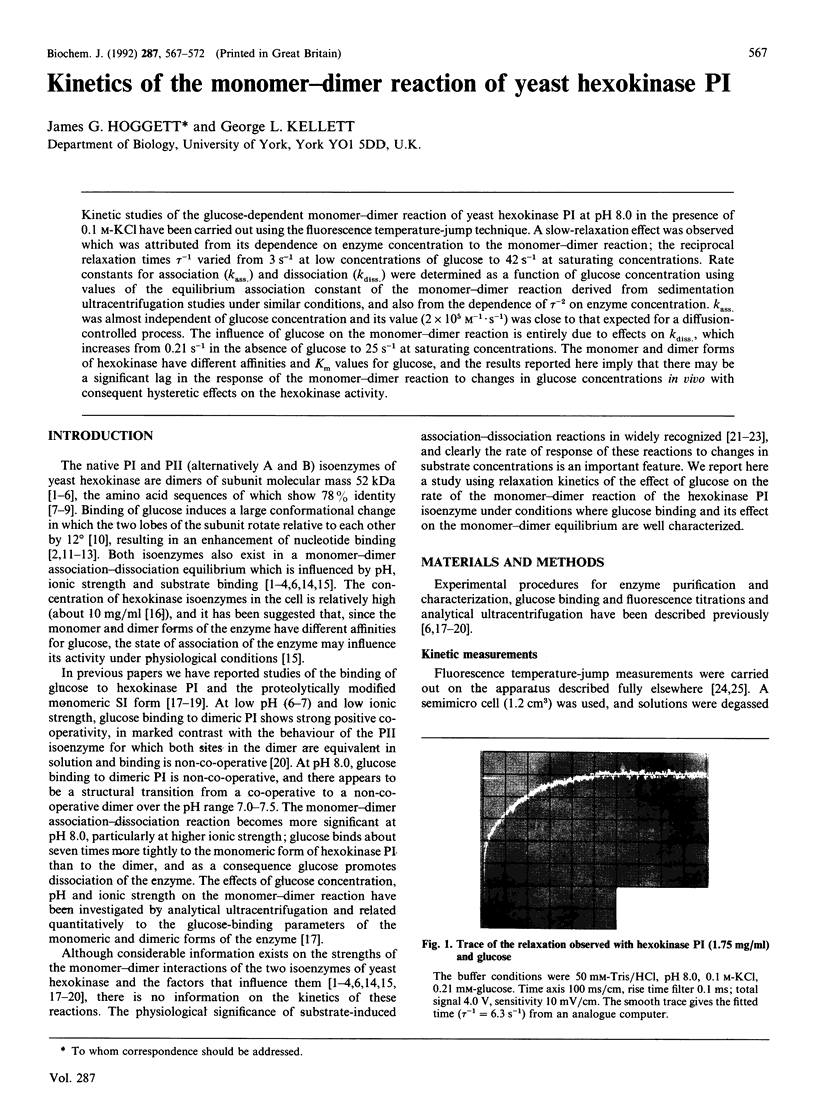
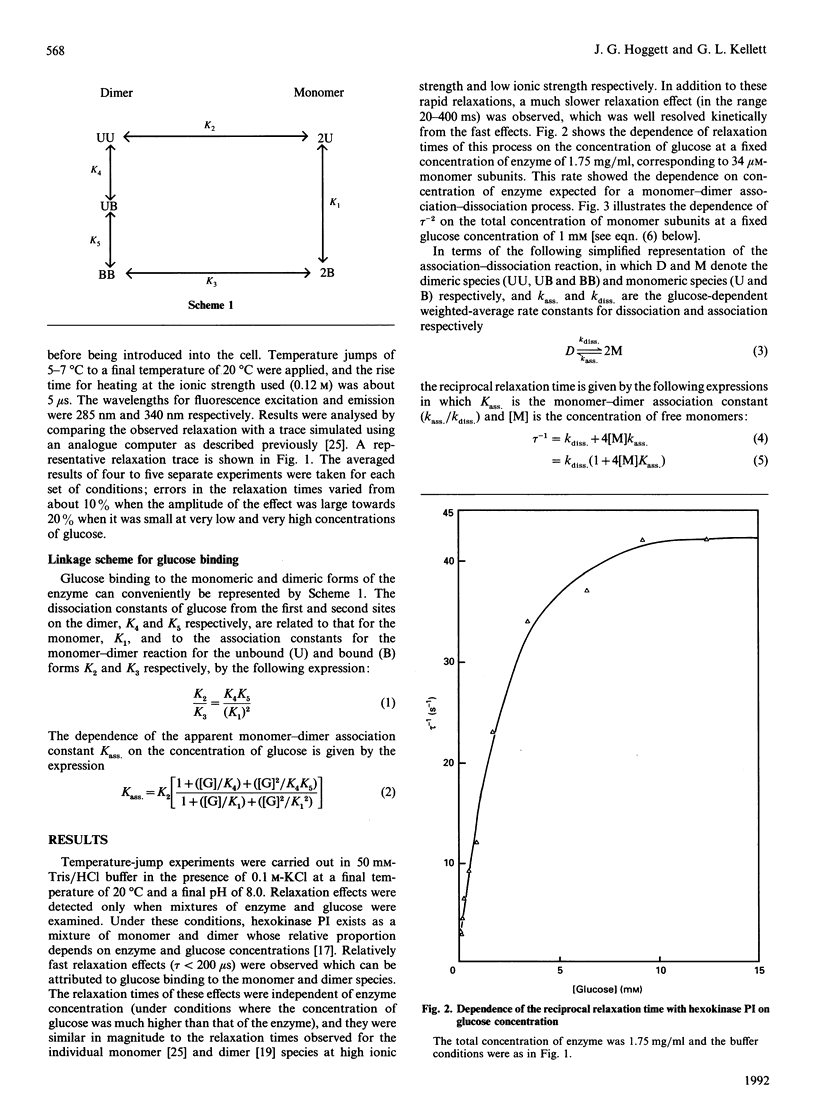
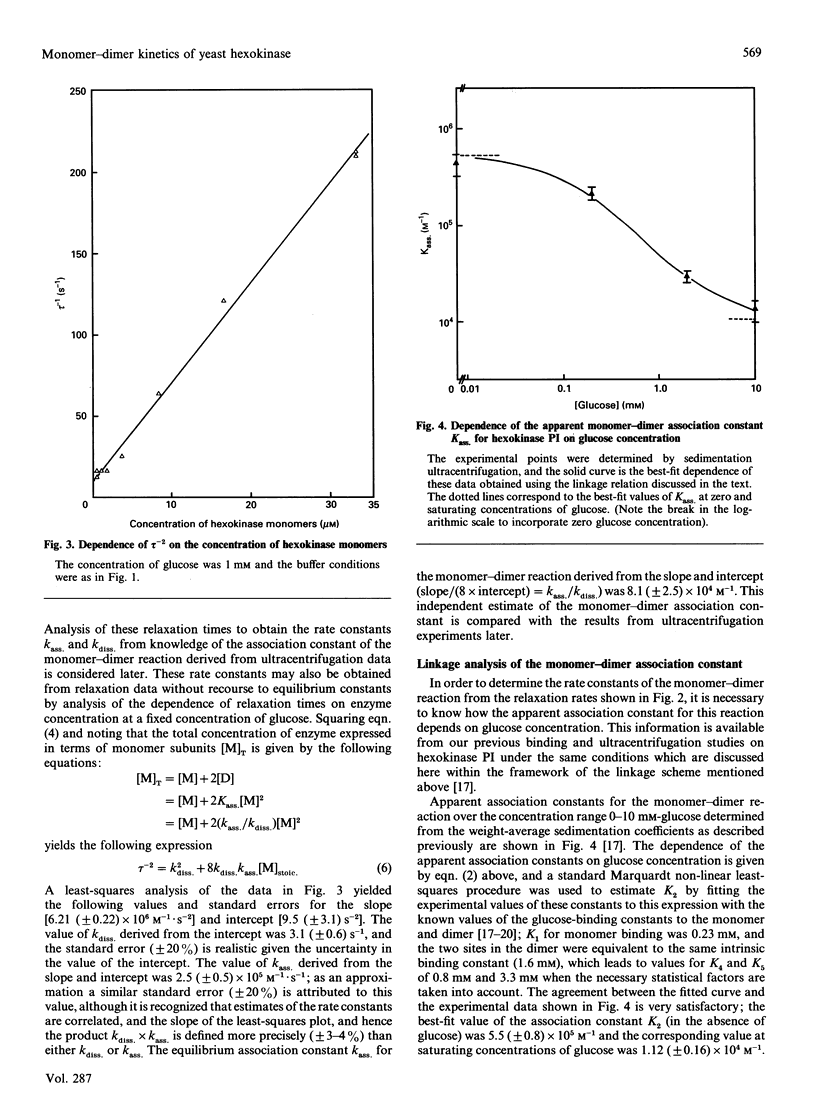
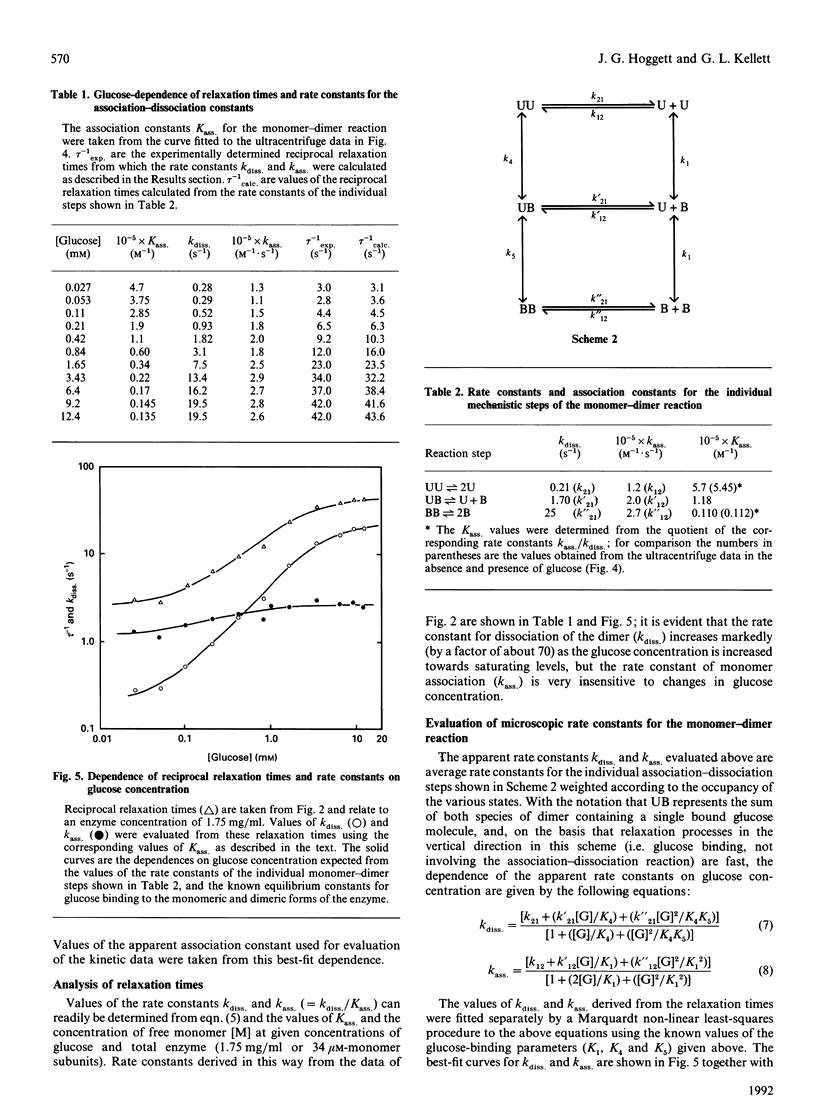
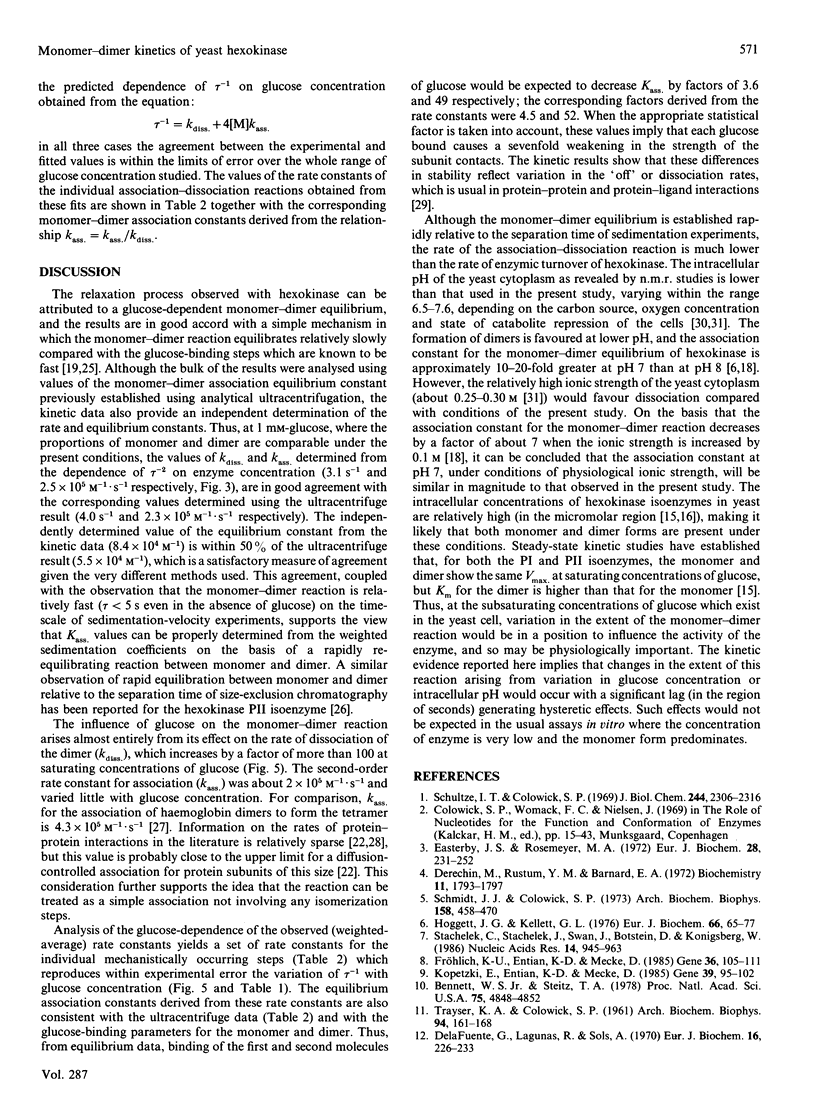
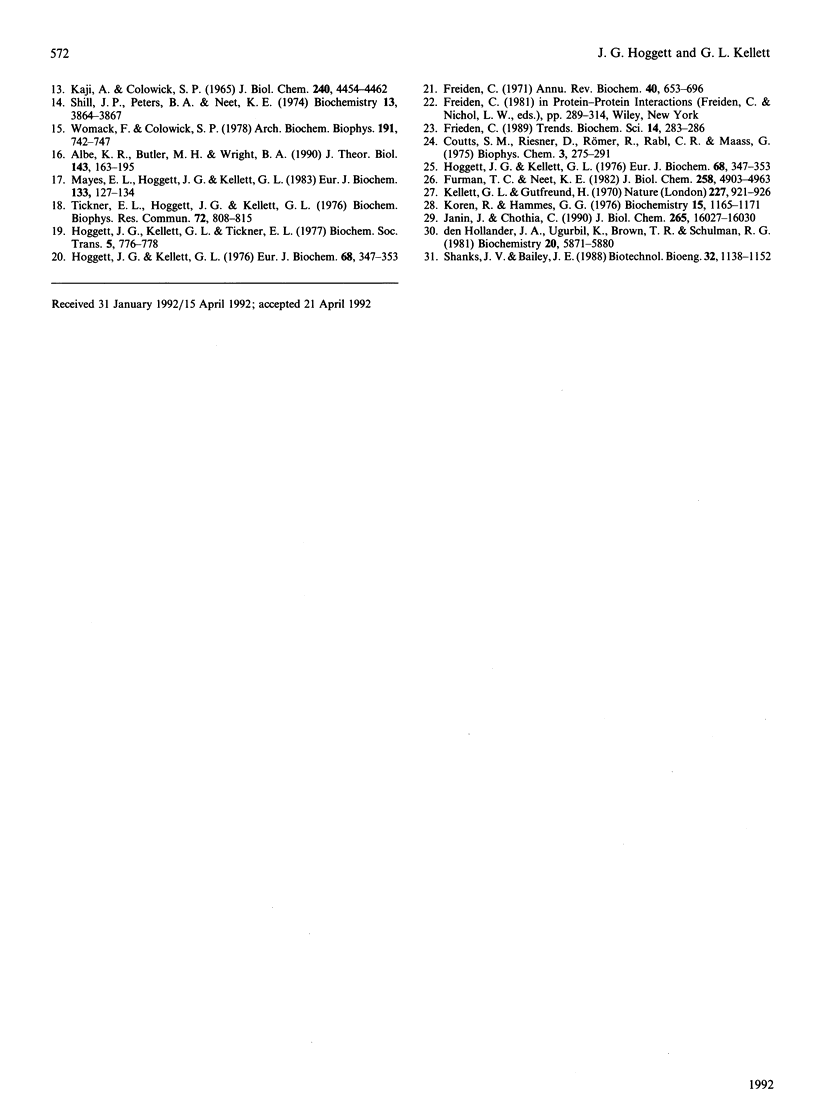
Images in this article
Selected References
These references are in PubMed. This may not be the complete list of references from this article.
- Albe K. R., Butler M. H., Wright B. E. Cellular concentrations of enzymes and their substrates. J Theor Biol. 1990 Mar 22;143(2):163–195. doi: 10.1016/s0022-5193(05)80266-8. [DOI] [PubMed] [Google Scholar]
- Bennett W. S., Jr, Steitz T. A. Glucose-induced conformational change in yeast hexokinase. Proc Natl Acad Sci U S A. 1978 Oct;75(10):4848–4852. doi: 10.1073/pnas.75.10.4848. [DOI] [PMC free article] [PubMed] [Google Scholar]
- Coutts S. M., Riesner D., Römer R., Rabl C. R., Maass G. Kinetics of conformational changes in tRNA Phe (yeast) as studied by the fluorescence of the Y-base and of formycin substituted for the 3'-terminal adenine. Biophys Chem. 1975 Oct;3(4):275–289. doi: 10.1016/0301-4622(75)80020-2. [DOI] [PubMed] [Google Scholar]
- DelaFuente G., Lagunas R., Sols A. Induced fit in yeast hexokinase. Eur J Biochem. 1970 Oct;16(2):226–233. doi: 10.1111/j.1432-1033.1970.tb01075.x. [DOI] [PubMed] [Google Scholar]
- Derechin M., Rustum Y. M., Barnard E. A. Dissociation of yeast hexokinase under the influence of substrates. Biochemistry. 1972 May 9;11(10):1793–1797. doi: 10.1021/bi00760a009. [DOI] [PubMed] [Google Scholar]
- Easterby J. S., Rosemeyer M. A. Purification and subunit interactions of yeast hexokinase. Eur J Biochem. 1972 Jul 13;28(2):241–252. doi: 10.1111/j.1432-1033.1972.tb01907.x. [DOI] [PubMed] [Google Scholar]
- Frieden C. Protein-protein interaction and enzymatic activity. Annu Rev Biochem. 1971;40:653–696. doi: 10.1146/annurev.bi.40.070171.003253. [DOI] [PubMed] [Google Scholar]
- Frieden C. The regulation of protein polymerization. Trends Biochem Sci. 1989 Jul;14(7):283–286. doi: 10.1016/0968-0004(89)90065-0. [DOI] [PubMed] [Google Scholar]
- Fröhlich K. U., Entian K. D., Mecke D. The primary structure of the yeast hexokinase PII gene (HXK2) which is responsible for glucose repression. Gene. 1985;36(1-2):105–111. doi: 10.1016/0378-1119(85)90074-5. [DOI] [PubMed] [Google Scholar]
- Hoggett J. G., Kellett G. L., Tickner E. L. A comparison of the binding of glucose of dimeric yeast hexokinase P-I and P-II isoenzymes [proceedings]. Biochem Soc Trans. 1977;5(3):776–778. doi: 10.1042/bst0050776. [DOI] [PubMed] [Google Scholar]
- Hoggett J. G., Kellett G. L. Yeast hexokinase. A fluorescence temperature-jump study of the kinetics of the binding of glucose to the monomer forms of hexokinases P-I and P-II. Eur J Biochem. 1976 Sep 15;68(2):347–353. doi: 10.1111/j.1432-1033.1976.tb10821.x. [DOI] [PubMed] [Google Scholar]
- Hoggett J. G., Kellett G. L. Yeast hexokinase. A fluorescence temperature-jump study of the kinetics of the binding of glucose to the monomer forms of hexokinases P-I and P-II. Eur J Biochem. 1976 Sep 15;68(2):347–353. doi: 10.1111/j.1432-1033.1976.tb10821.x. [DOI] [PubMed] [Google Scholar]
- Hoggett J. G., Kellett G. L. Yeast hexokinase: substrate-induced association--dissociation reactions in the binding of glucose to hexokinase P-II. Eur J Biochem. 1976 Jun 15;66(1):65–77. doi: 10.1111/j.1432-1033.1976.tb10426.x. [DOI] [PubMed] [Google Scholar]
- Janin J., Chothia C. The structure of protein-protein recognition sites. J Biol Chem. 1990 Sep 25;265(27):16027–16030. [PubMed] [Google Scholar]
- Kaji A., Colowick S. P. Adenosine triphosphatase activity of yeast hexokinase and its relation to the mechanism of the hexokinase reaction. J Biol Chem. 1965 Nov;240(11):4454–4462. [PubMed] [Google Scholar]
- Kellett G. L., Gutfreund H. Reactions of haemoglobin dimers after ligand dissociation. Nature. 1970 Aug 29;227(5261):921–926. doi: 10.1038/227921a0. [DOI] [PubMed] [Google Scholar]
- Kopetzki E., Entian K. D., Mecke D. Complete nucleotide sequence of the hexokinase PI gene (HXK1) of Saccharomyces cerevisiae. Gene. 1985;39(1):95–101. doi: 10.1016/0378-1119(85)90113-1. [DOI] [PubMed] [Google Scholar]
- Koren R., Hammes G. G. A kinetic study of protein-protein interactions. Biochemistry. 1976 Mar 9;15(5):1165–1171. doi: 10.1021/bi00650a032. [DOI] [PubMed] [Google Scholar]
- Mayes E. L., Hoggett J. G., Kellett G. L. The binding of glucose to native and proteolytically modified yeast hexokinase PI. Eur J Biochem. 1983 Jun 1;133(1):127–134. doi: 10.1111/j.1432-1033.1983.tb07437.x. [DOI] [PubMed] [Google Scholar]
- Schmidt J. J., Colowick S. P. Chemistry and subunit structure of yeast hexokinase isoenzymes. Arch Biochem Biophys. 1973 Oct;158(2):458–470. doi: 10.1016/0003-9861(73)90537-7. [DOI] [PubMed] [Google Scholar]
- Schulze I. T., Colowick S. P. The modification of yeast hexokinases by proteases and its relationship to the dissociation of hexokinase into subunits. J Biol Chem. 1969 May 10;244(9):2306–2316. [PubMed] [Google Scholar]
- Shill J. P., Peters B. A., Neet K. E. Monomer-dimer equilibria of yeast hexokinase during reacting enzyme sedimentation. Biochemistry. 1974 Sep 10;13(19):3864–3871. doi: 10.1021/bi00716a007. [DOI] [PubMed] [Google Scholar]
- Stachelek C., Stachelek J., Swan J., Botstein D., Konigsberg W. Identification, cloning and sequence determination of the genes specifying hexokinase A and B from yeast. Nucleic Acids Res. 1986 Jan 24;14(2):945–963. doi: 10.1093/nar/14.2.945. [DOI] [PMC free article] [PubMed] [Google Scholar]
- TRAYSER K. A., COLOWICK S. P. Properties of crystalline hexokinase from yeast. II. Studies on ATP-enzyme interaction. Arch Biochem Biophys. 1961 Jul;94:161–168. doi: 10.1016/0003-9861(61)90024-8. [DOI] [PubMed] [Google Scholar]
- Tickner E. L., Hoggett J. G., Kellett G. L. The cooperative binding of glucose to yeast hexokinase PI dimer. Biochem Biophys Res Commun. 1976 Oct 4;72(3):808–815. doi: 10.1016/s0006-291x(76)80205-7. [DOI] [PubMed] [Google Scholar]
- Womack F., Colowick S. P. Catalytic activity with associated and dissociated forms of the yeast hexokinases. Arch Biochem Biophys. 1978 Dec;191(2):742–747. doi: 10.1016/0003-9861(78)90415-0. [DOI] [PubMed] [Google Scholar]
- den Hollander J. A., Ugurbil K., Brown T. R., Shulman R. G. Phosphorus-31 nuclear magnetic resonance studies of the effect of oxygen upon glycolysis in yeast. Biochemistry. 1981 Sep 29;20(20):5871–5880. doi: 10.1021/bi00523a034. [DOI] [PubMed] [Google Scholar]



